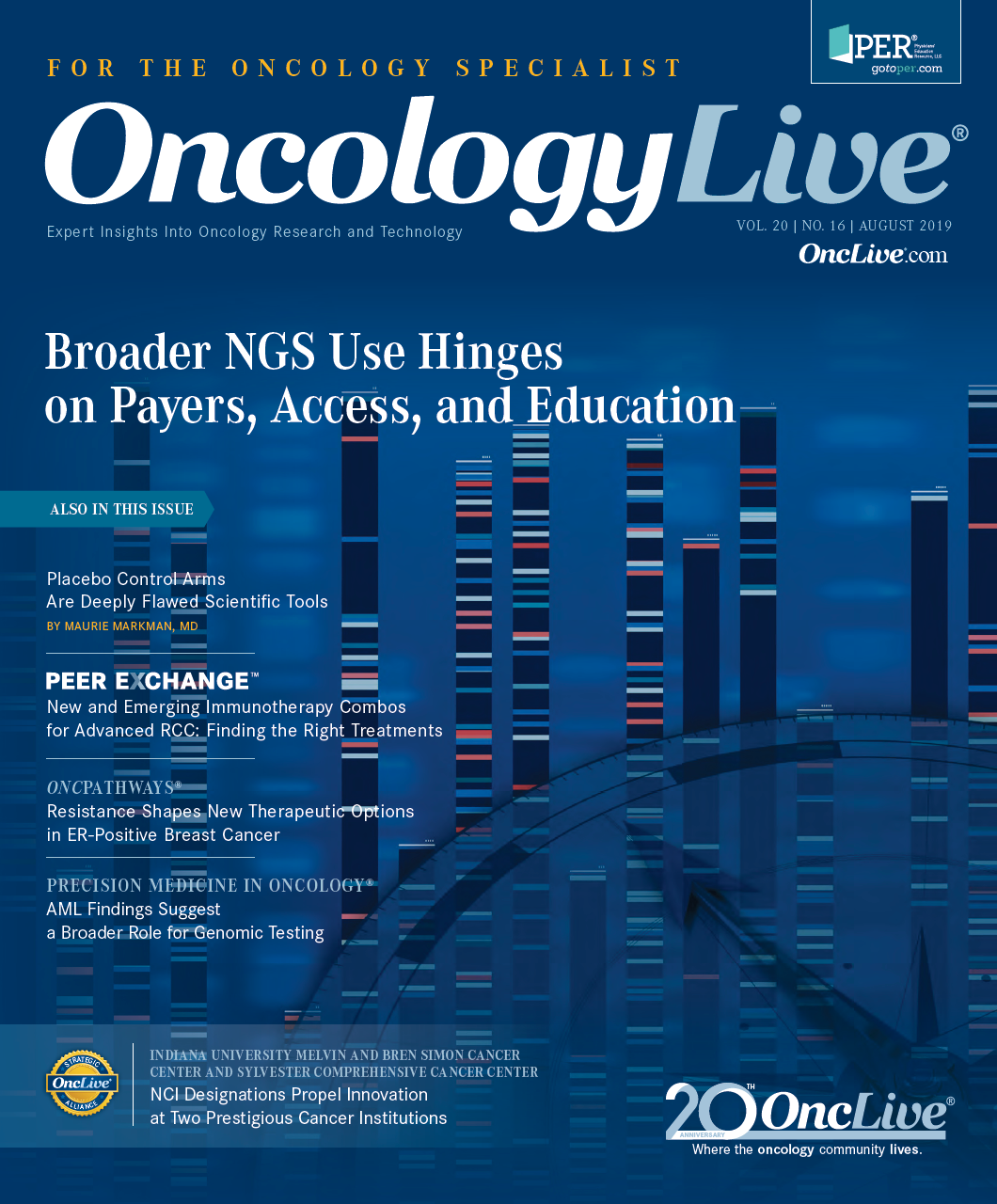AML Findings Suggest a Broader Role for Genomic Testing
Genomic profiling provides evidence of measurable residual disease in patients with acute myeloid leukemia and may help guide the choice of a preconditioning regimen in those who are at risk of relapse after undergoing allogeneic hematopoietic cell transplantation.
Christopher Hourigan, MD, DPhil

Christopher Hourigan, MD, DPhil
Genomic profiling provides evidence of measurable residual disease (MRD) in patients with acute myeloid leukemia (AML) and may help guide the choice of a preconditioning regimen in those who are at risk of relapse after undergoing allogeneic hematopoietic cell transplantation (alloHCT), according to findings presented at the 2019 European Hematology Association Congress.
Investigators said “ultradeep” next-generation sequencing (NGS) using blood samples from patients with AML who were in complete remission according to a standard definition showed that posttransplant outcomes were worse for patients with genomic variants who received reduced-intensity conditioning (RIC) before alloHCT than for those treated with a myeloablative (MAC) regimen before transplant.1
NGS techniques could help refine the characterization of MRD in AML, which lacks a clear definition of this benchmark, lead study author Christopher Hourigan, MD, DPhil, said.
Unlike lymphoid malignancies, Hourigan noted, AML does not have a clonal-specific rearranged receptor sequence by which clinicians can track MRD. “MRD is a subject that everyone has an opinion on,” said Hourigan, an investigator at the National Heart, Lung, and Blood Institute, National Institutes of Health, in Bethesda, Maryland. “The key question remaining is: Is MRD just useful for predicting prognosis, or can we, as doctors, do something about it?”
As a launching point for the study, investigators used samples from patients who participated in the phase III BMT CTN 0901 (NCT01339910) trial that compared the RIC and MAC regimens in patients who were in complete remission pretransplant. The BMT CTN trial was stopped before enrollment was completed because of an observed survival benefit among those receiving MAC.1
The BMT CTN study recruited patients with AML or myelodysplastic syndrome with less than 5% myeloblasts in the bone marrow and no leukemic myeloblasts in the peripheral blood on morphologic analysis 30 days before the start of the conditioning regimen enrollment. In all, 228 patients with AML were randomized to RIC or MAC. Participants in the RIC group received fludarabine plus busulfan or fludarabine plus melphalan. Patients in the MAC arm received 1 of 3 regimens: busulfan plus cyclophosphamide, busulfan plus fludarabine, or cyclophosphamide plus total body irradiation.2
Table. Custom Gene Panel for Detection of MRD in AML1
Overall survival (OS) at 18 months for patients with AML who received RIC was 63.4% (95% CI, 53.6%-71.6%) versus 76.4% (95% CI, 67.1%-83.4%) for those who received MAC (P = .035). The relapse rate on the RIC arm was 51.0% (95% CI, 41.2%-60.0%) versus 15.9% (95% CI, 9.7%-23.5%) on the MAC arm.3 In their supplementary study, Hourigan and colleagues evaluated 188 whole blood samples from participants in the BMT CTN trial, collected equally from patients who received RIC and MAC who were well matched for other baseline characteristics.
The samples underwent ultradeep NGS using a custom panel of 13 commonly mutated AML genes that would detect at least 1 variant in approximately 80% of patients with an NGS variant (Table).1 The investigators detected 313 variants in the samples. One-third of patients in each arm (33% and 31% in RIC and MAC, respectively) had no variants detected. In those with variants, investigators detected an average of 2.5 variants per patient.1
Among patients in whom no variant was detected, similar survival rates were observed with RIC and MAC; the 3-year OS was 58% for RIC and 65% for MAC (P = .98).
In those with detectable variants, outcomes were significantly worse for patients who received RIC than for those who received MAC. The 3-year OS rates for the 2 regimens were 44% versus 61%, respectively (P = .02).
In those relapsing in the first year after transplant, 76% had at least 1 detectable variant before preconditioning. In a multivariate analysis of those with detectable variants, adjusting for disease risk and donor group, RIC was significantly associated with increased relapse (HR, 5.98 [3.19-11.26]; P <.001), decreased disease-free survival (HR, 2.80 [1.76-4.44]; P <.001), and decreased OS (HR, 2.16 [1.30-3.60]; P = .003) compared with MAC.
Methods of Assessing MRD
National Comprehensive Cancer Network guidelines note that integration of MRD testing into clinical practice in AML is hampered by a lack of standardization and established cutoff values. The most commonly used techniques are real-time quantitative polymerase chain reaction (RQ-PCR) testing, multicolor flow cytometry, and NGS panel assays. The optimal sample depends on the technique: peripheral blood for RQ-PCR and the first pull or early pull of bone marrow aspirate for cytometry and NGS.4
In their study, Hourigan said, the rationale for using NGS over the other techniques reflected the restraints posed by the samples. Flow cytometry requires viable cells, and RQ-PCR requires intact RNA, and neither is available in the whole blood samples.
Hourigan emphasized that because of the limitations of clinical and commercial tests, NGS is not in a position to take over standard MRD evaluation techniques. “Most of the NGS tests that are currently available, whether in a local academic center or [through] a commercial vendor, just are not fit for the purpose of [identifying] residual disease, [but] they are great for diagnostic profiling or disease burden,” Hourigan said in an interview with OncologyLive®. “We’ve got a way to go before we can do NGS for MRD routinely, but I think that will be the future.”
Next steps in this research include determining whether NGS positivity equates to MRD positivity, enhancing the 13-gene panel to improve false-negative rates, and identifying which patients would benefit most from RIC.
“In AML, because it is genetically heterogenous, it is a much harder task [to identify MRD], since there is not 1 test that will work,” Hourigan said. “We are several years behind in AML, but we see how useful measuring residual disease is in other blood cancers, and that’s really appealing. We’d love to do the same with our patients.”
References
- Hourigan C, Dillon L, Logan B, et al. Impact of conditioning intensity of allogeneic transplantation for acute myeloid leukemia with genomic evidence of residual disease. Abstract presented at: 2019 European Hematology Association Congress; June 13- 16, 2019; Amsterdam, Netherlands. Abstract PS1370. bit.ly/30MdCCD.
- Reduced Intensity Regimen vs Myeloablative Regimen for Myeloid Leukemia or Myelodysplastic Syndrome (BMT CTN 0901). clinicaltrials. gov/ct2/show/NCT01339910?term=NCT01339910&rank=1. Updated May 30, 2019. Accessed July 20, 2019.
- Scott BL, Pasquini MC, Logan BR, et al. Myeloablative versus reduced-intensity hematopoietic cell transplantation for acute myeloid leukemia and myelodysplastic syndromes. J Clin Oncol. 2017;35(11):1154-1161. doi: 10.1200/JCO.2016.70.7091.
- NCCN Clinical Practice Guidelines in Oncology. Acute Myeloid Leukemia, version 3.2019. National Comprehensive Cancer Network website. nccn.org/professionals/physician_gls/pdf/ aml.pdf. Updated May 7, 2019. Accessed July 18, 2019.




